Highlights
Electrically tunable quantum interference of atomic spins
Nature Communications 16, 8988 (2025)Controlling quantum interference near avoided energy-level crossings is crucial for fast and reliable coherent manipulation in quantum information processing. However, achieving tunable quantum interference in atomically-precise engineered structures remains challenging. Here, we demonstrate electrical control of quantum interference using atomic spins on an insulating film in a scanning tunneling microscope. Using bias voltages applied across the tunnel junction, we modulate the atomically-confined magnetic interaction between the probe tip and surface atoms with a strong electric field, and drive the spin state rapidly through the energy-level anticrossing. This all-electrical manipulation allows us to achieve Landau-Zener-Stückelberg-Majorana (LZSM) interferometry on both single spins and pairs of interacting spins. The LZSM pattern exhibits multiphoton resonances, and its asymmetry suggests that the spin dynamics is influenced by spin-transfer torque of tunneling electrons. Multi-level LZSM spectra measured on coupled spins with tunable interactions show distinct interference patterns depending on their many-body energy landscapes. These results open new avenues for all-electrical quantum manipulation in spin-based quantum processors in the strongly driven regime.
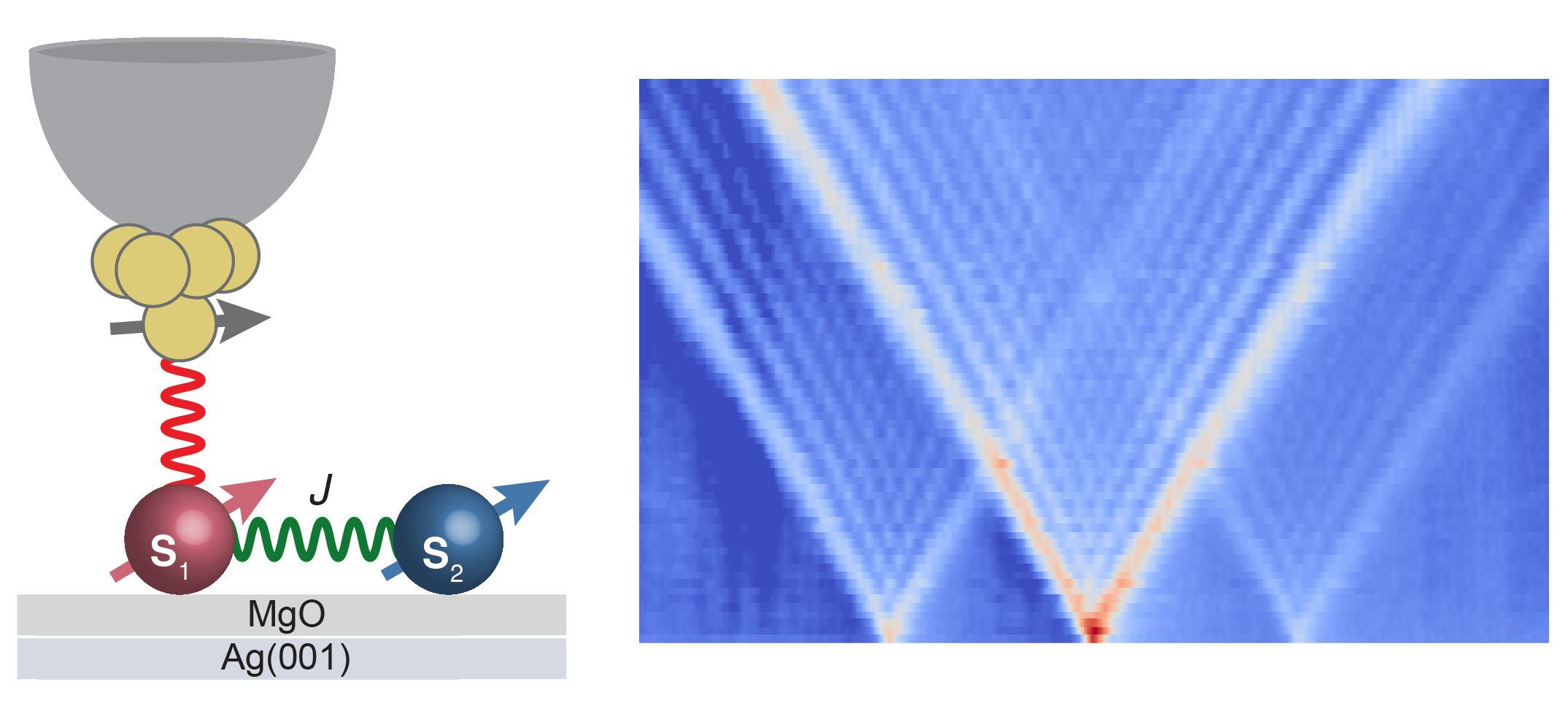
Landau-Zener-Stückelberg-Majorana (LZSM) interference
Constructing topological quantum magnets from atomic spins
Nature Nanotechnology 19, 1782 (2024)Artificial quantum systems have emerged as platforms to realize topological matter in a well-controlled manner. So far experiments have mostly explored non-interacting topological states and the realization of many-body topological phases in solid-state platforms with atomic resolution has remained challenging. Here, we construct topological quantum Heisenberg spin lattices by assembling spin chains and two-dimensional spin arrays from spin-1/2 Ti atoms on an insulating MgO film in a scanning tunnelling microscope (STM). We engineer both topological and trivial phases of the quantum spin model and thereby realize first- and second-order topological quantum magnets. We probe the many-body excitations of the quantum magnets by single-atom electron spin resonance with an energy resolution better than 100 neV. Making use of the atomically-localized magnetic field of the STM tip, we visualize various many-body topological bound modes including topological edge states, topological defects, and higher-order corner modes. Our results provide a bottom-up approach for the simulation of exotic quantum many-body phases of interacting spins.
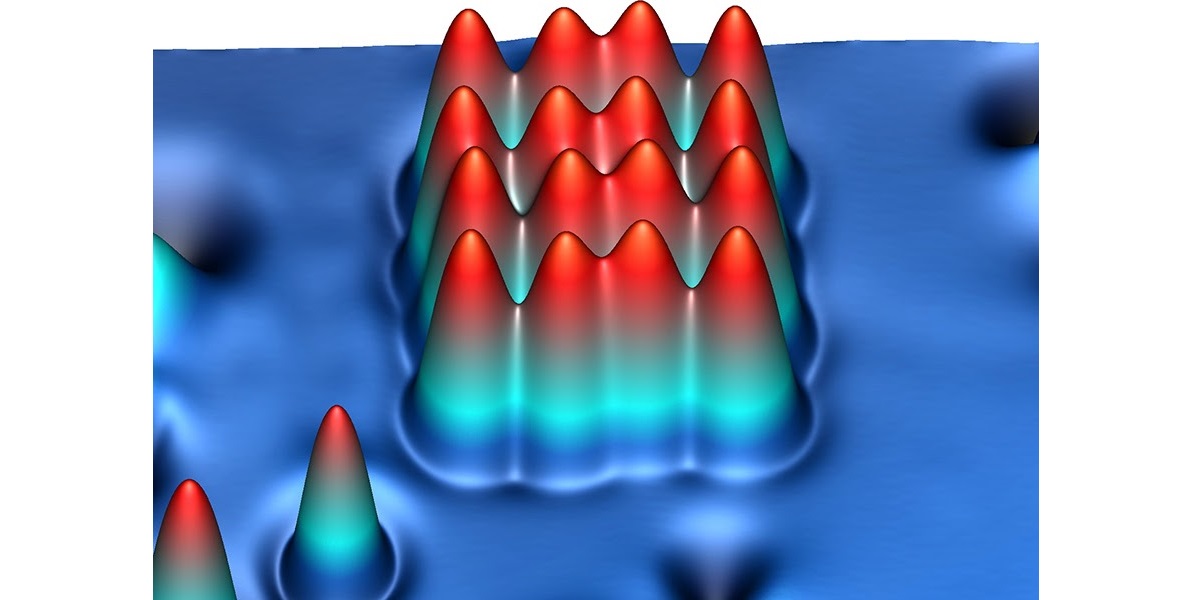
Higher-order topological quantum magnet
Simulating RVB states with surface spins
Nature Communications 12, 993 (2021)Designing and characterizing the many-body behaviors of quantum materials represents a prominent challenge for understanding strongly correlated physics and quantum information processing. We constructed artificial quantum magnets on a surface by using spin-1/2 atoms in a scanning tunneling microscope (STM). These coupled spins feature strong quantum fluctuations due to antiferromagnetic exchange interactions between neighboring atoms. To characterize the resulting collective magnetic states and their energy levels, we performed electron spin resonance on individual atoms within each quantum magnet. This gives atomic-scale access to properties of the exotic quantum many-body states, such as a finite-size realization of a resonating valence bond state. The tunable atomic-scale magnetic field from the STM tip allows us to further characterize and engineer the quantum states. These results open a new avenue to designing and exploring quantum magnets at the atomic scale for applications in spintronics and quantum simulations.
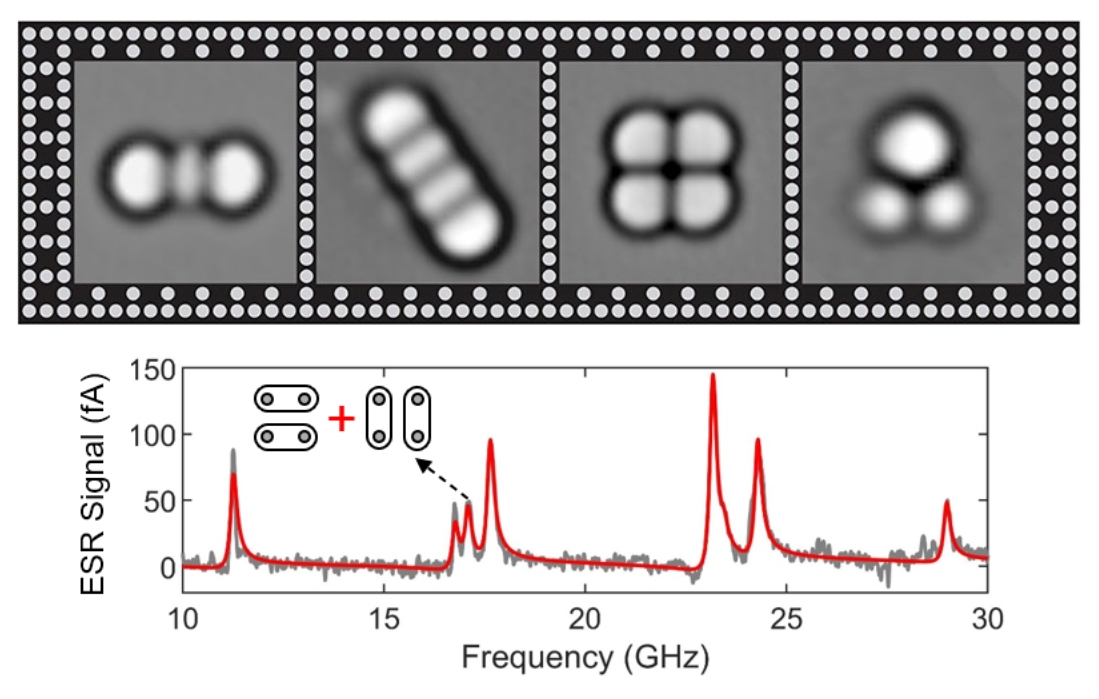
RVB states in artificial quantum magnets
Coherent surface spin manipulation
Science 366, 509 (2019)Spin-based quantum information processing requires coherent spin manipulation. We demonstrate coherent control of surface titanium and iron atom spins on a magnesium oxide surface with a magnetic scanning tunneling microscope tip. Arbitrary sequences of fast electrical pulses delivered to the top induced large electric fields. These fields drove metal-atom movement, which then modulated the tip-atom exchange interaction to create an oscillating effective magnetic field. Advanced spin-control protocols such as Ramsey fringes and Hahn spin echoes revealed quantum dynamics, such as coherent oscillations in a titanium atom dimer assembled on the surface with the tip.
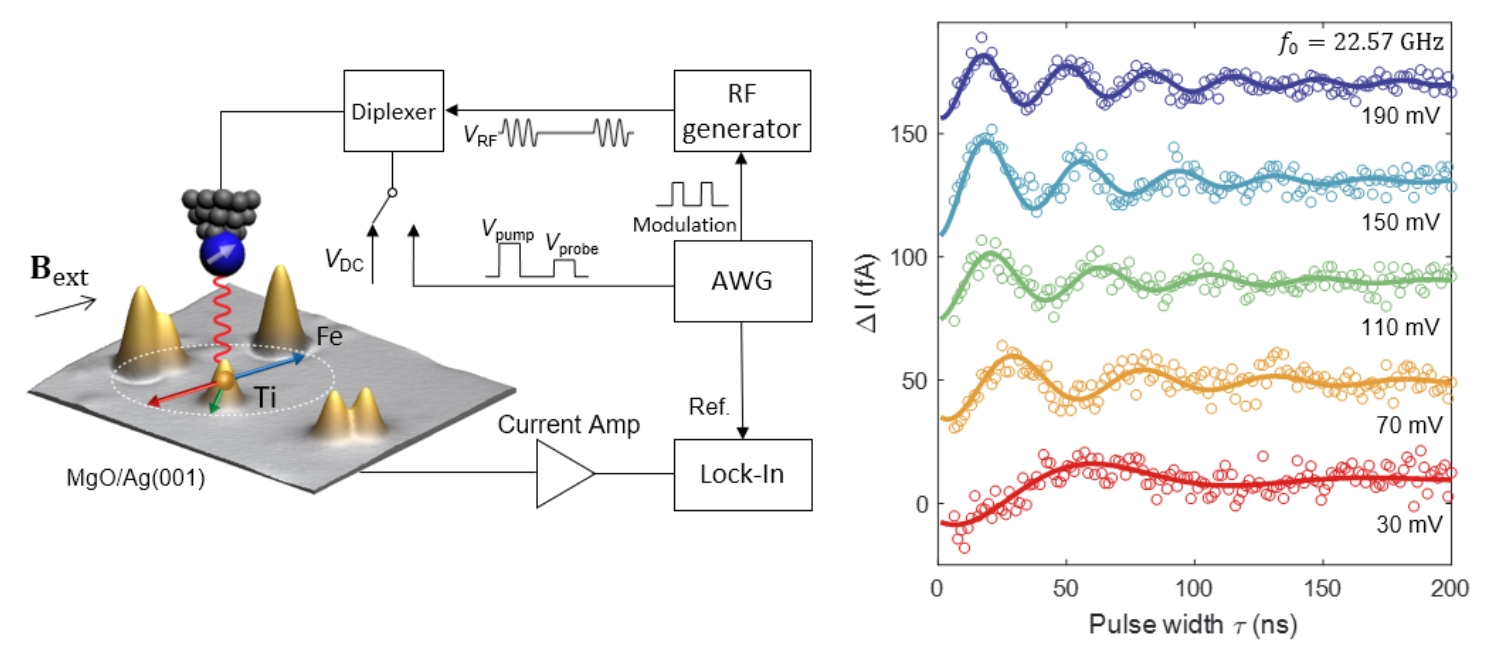
Rabi oscillations of a single Ti atom measured by pulsed ESR-STM
Tuning the exchange bias on a single atom
Physical Review Letters 122, 227203 (2019)Shrinking spintronic devices to the nanoscale ultimately requires localized control of individual atomic magnetic moments. At these length scales, the exchange interaction plays important roles, such as in the stabilization of spin-quantization axes, the production of spin frustration, and creation of magnetic ordering. Here, we demonstrate the precise control of the exchange bias experienced by a single atom on a surface, covering an energy range of 4 orders of magnitude. The exchange interaction is continuously tunable from milli-eV to micro-eV by adjusting the separation between a spin-1/2 atom on a surface and the magnetic tip of a scanning tunneling microscope. We seamlessly combine inelastic electron tunneling spectroscopy and electron spin resonance to map out the different energy scales. This control of exchange bias over a wide span of energies provides versatile control of spin states, with applications ranging from precise tuning of quantum state properties, to strong exchange bias for local spin doping. In addition, we show that a time-varying exchange interaction generates a localized ac magnetic field that resonantly drives the surface spin. The static and dynamic control of the exchange interaction at the atomic scale provides a new tool to tune the quantum states of coupled-spin systems.
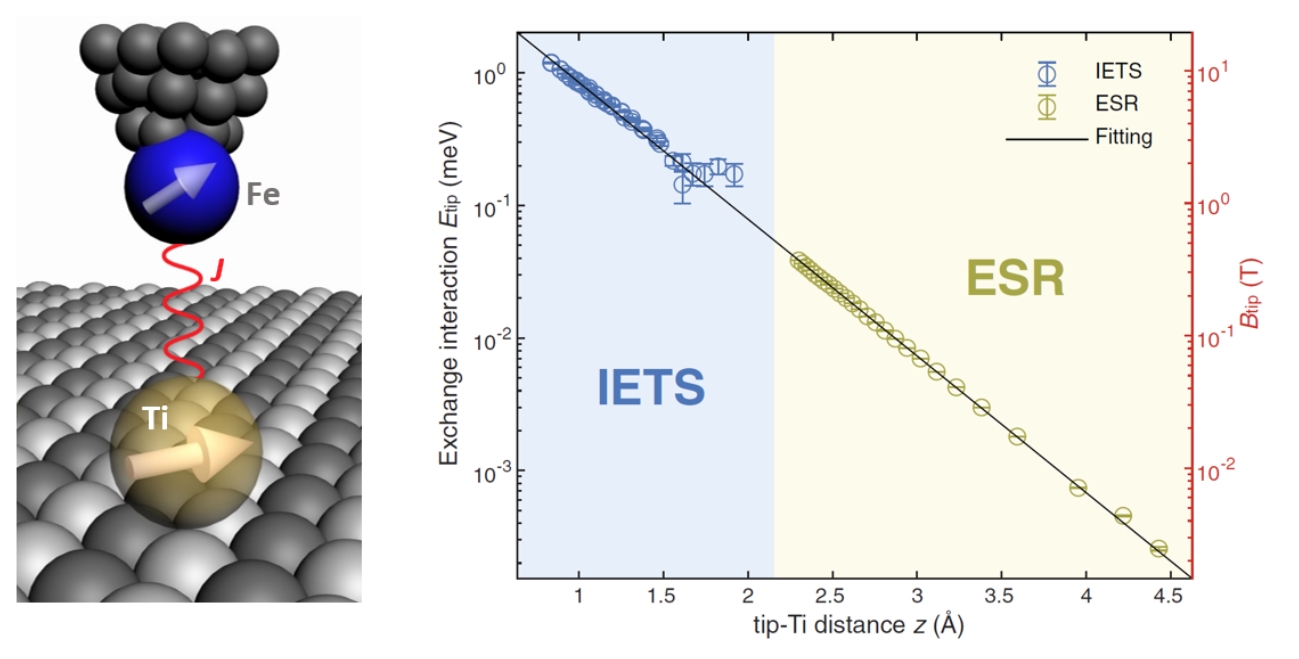
Spin-spin exchange interaction as a function of tip-to-atom distance
Tunable giant magnetoresistance in a single-molecule junction
Nature Communications 10, 3599 (2019)Controlling electronic transport through a single-molecule junction is crucial for molecular electronics or spintronics. In magnetic molecular devices, the spin degree-of-freedom can be used to this end since the magnetic properties of the magnetic ion centers fundamentally impact the transport through the molecules. Here we demonstrate that the electron pathway in a single-molecule device can be selected between two molecular orbitals by varying a magnetic field, giving rise to a tunable anisotropic magnetoresistance up to 93%. The unique tunability of the electron pathways is due to the magnetic reorientation of the transition metal center, resulting in a re-hybridization of molecular orbitals. We obtain the tunneling electron pathways by Kondo effect, which manifests either as a peak or a dip line shape. The energy changes of these spin-reorientations are remarkably low and less than one millielectronvolt. The large tunable anisotropic magnetoresistance could be used to control electronic transport in molecular spintronics.
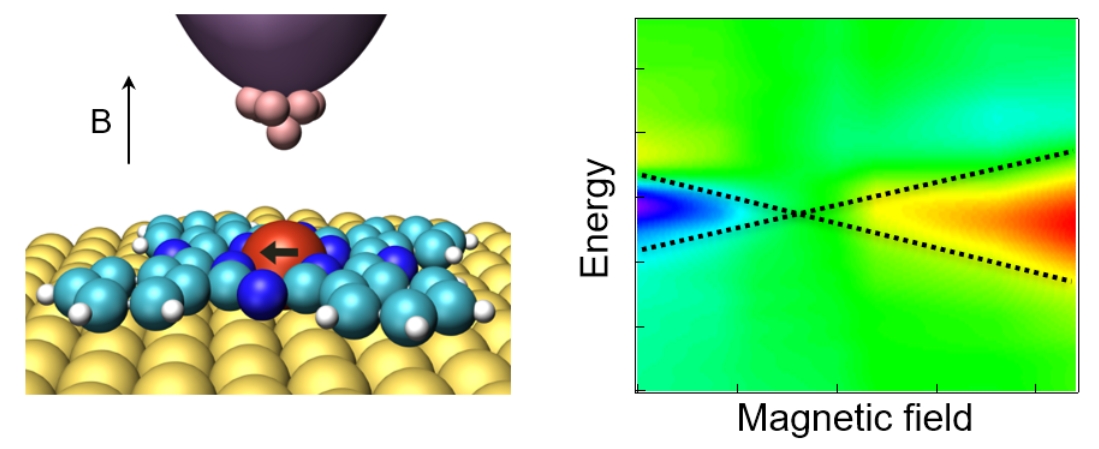
Dip-to-peak transition of Kondo resonance in a single magnetic molecule
Magnetic resonance imaging of single atoms on a surface
Nature Physics 15, 1005 (2019)Magnetic resonance imaging (MRI) revolutionized diagnostic medicine and biomedical research by allowing non-invasive access to spin ensembles. To enhance MRI resolution to the nanometre scale, new approaches including scanning probe methods have been used in recent years, which culminated in the detection of individual spins. This allowed for the visualization of organic samples and magnetic structures, as well as identifying the location of electron and nuclear spins. Here, we demonstrate the MRI of individual atoms on a surface. The set-up, implemented in a cryogenic scanning tunnelling microscope, uses single-atom electron spin resonance to achieve sub-ångström resolution, exceeding the spatial resolution of previous MRI experiments by one to two orders of magnitude. We find that MRI scans of different atomic species and with different probe tips lead to unique signatures in the resonance images. These signatures reveal the magnetic interactions between the tip and the atom, in particular magnetic dipolar and exchange interaction.

MRI of single Ti atoms measured by ESR-STM
Nuclear magnetic resonance at the single-atom scale
Nature Nanotechnology 13, 1120 (2018)Nuclear magnetic resonance (NMR), the resonant control of nuclear spins, is a powerful probe of the local magnetic and chemical environments of the nuclei. Addressing nuclear spins individually, in order to sense the distinct environment of each atom, is difficult due to the small nuclear magnetic moment. In this work, we used the spin-polarized current from the STM tip to polarize the nuclear spin of individual Cu atoms, and use the electric field to resonantly drive nuclear spin transitions. By employing the electron–nuclear hyperfine interaction, the spin angular momentum is transferred from tunneling electrons to the nucleus of individual Cu atoms. The current-controlled nuclear polarization should be also present in other quantum systems such as the nuclear spins embedded in single-molecule magnets. Thus, this technique offers a general route towards electrically-controlled nuclear spin devices. Electrically-driven NMR also provides a new means to detect the atomic-scale magnetic environment in nanomagnets.
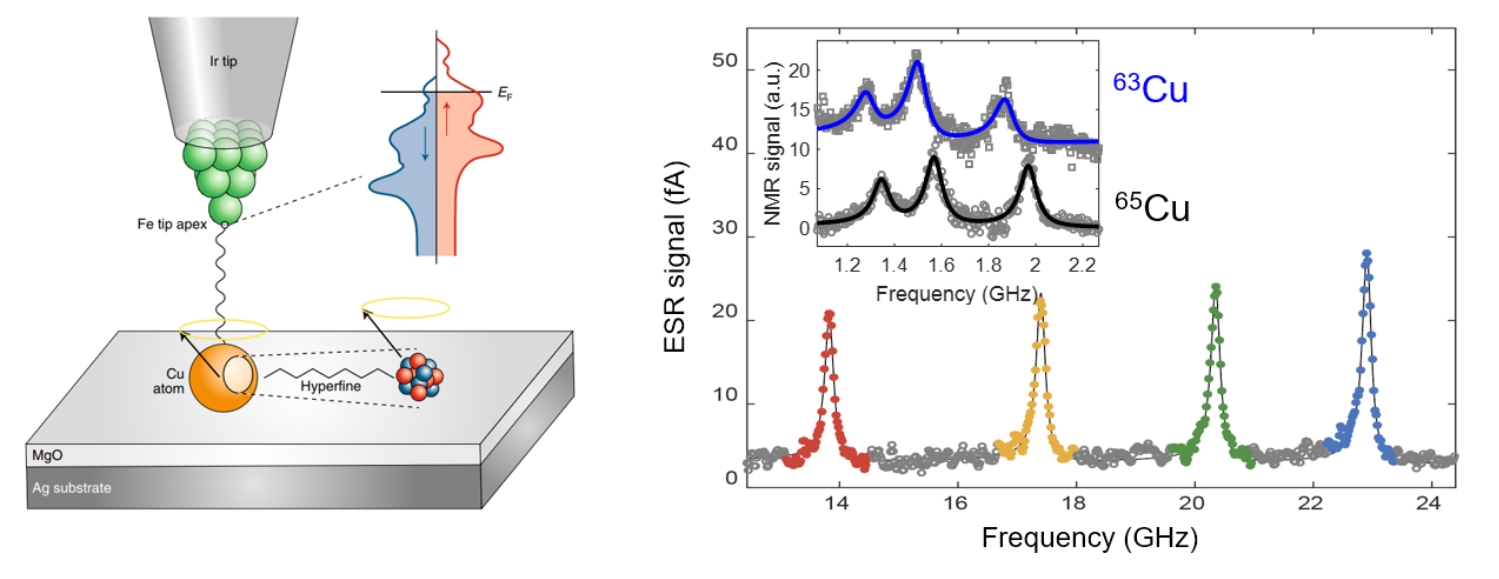
ESR and NMR spectra of single Cu atoms
Enhancing quantum coherence by singlet-triplet transitions
Science Advances 4, eaau4159 (2018)Manipulation of spin states at the single-atom scale underlies spin-based quantum information processing and spintronic devices. These applications require protection of the spin states against quantum decoherence due to interactions with the environment. While a single spin is easily disrupted, a coupled-spin system can resist decoherence by using a subspace of states that is immune to magnetic field fluctuations. Here, we engineered the magnetic interactions between the electron spins of two spin-1/2 atoms to create a “clock transition” and thus enhance their spin coherence. To construct and electrically access the desired spin structures, we use atom manipulation combined with electron spin resonance (ESR) in a scanning tunneling microscope. We show that a two-level system composed of a singlet state and a triplet state is insensitive to local and global magnetic field noise, resulting in much longer spin coherence times compared with individual atoms. Moreover, the spin decoherence resulting from the interaction with tunneling electrons is markedly reduced by a homodyne readout of ESR. These results demonstrate that atomically precise spin structures can be designed and assembled to yield enhanced quantum coherence.
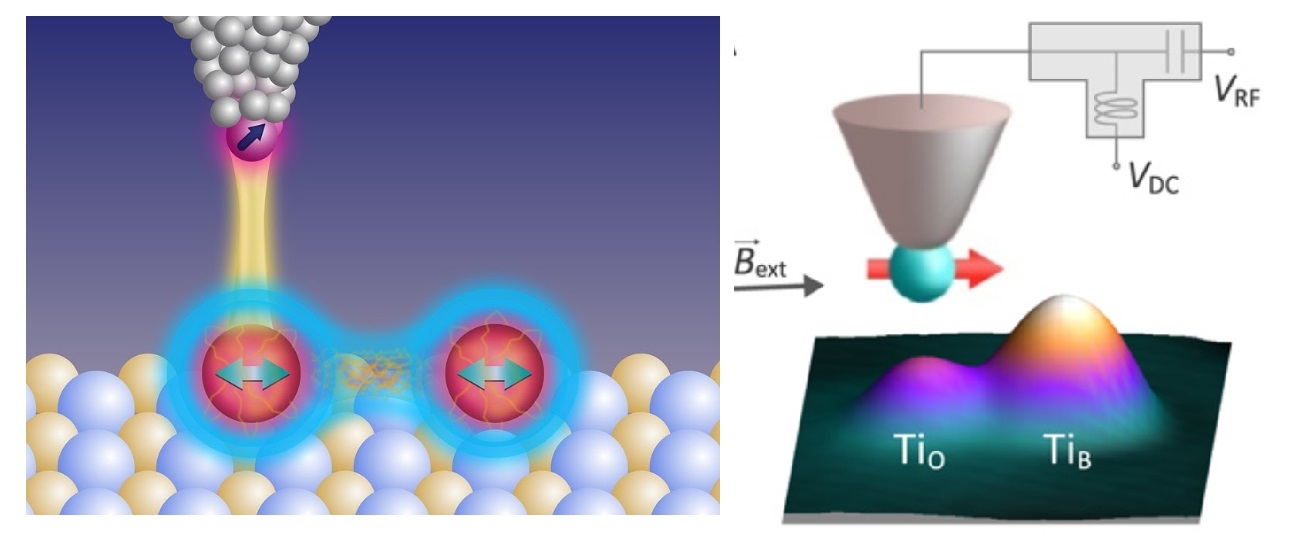
Driving singlet-triplet transitions in a spin dimer
Engineering the eigenstates of coupled spin-1/2 atoms
Physical Review Letters 119, 227206 (2017)Quantum spin networks having engineered geometries and interactions are eagerly pursued for quantum simulation and access to emergent quantum phenomena such as spin liquids. Spin-1/2 centers are particularly desirable, because they readily manifest coherent quantum fluctuations. Here we introduce a controllable spin-1/2 architecture consisting of titanium atoms on a magnesium oxide surface. We tailor the spin interactions by atomic-precision positioning using a scanning tunneling microscope (STM) and subsequently perform electron spin resonance on individual atoms to drive transitions into and out of quantum eigenstates of the coupled-spin system. Interactions between the atoms are mapped over a range of distances extending from highly anisotropic dipole coupling to strong exchange coupling. The local magnetic field of the magnetic STM tip serves to precisely tune the superposition states of a pair of spins. The precise control of the spin-spin interactions and ability to probe the states of the coupled-spin network by addressing individual spins will enable the exploration of quantum many-body systems based on networks of spin-1/2 atoms on surfaces.

Tuning spin-spin entanglement in a spin-1/2 dimer